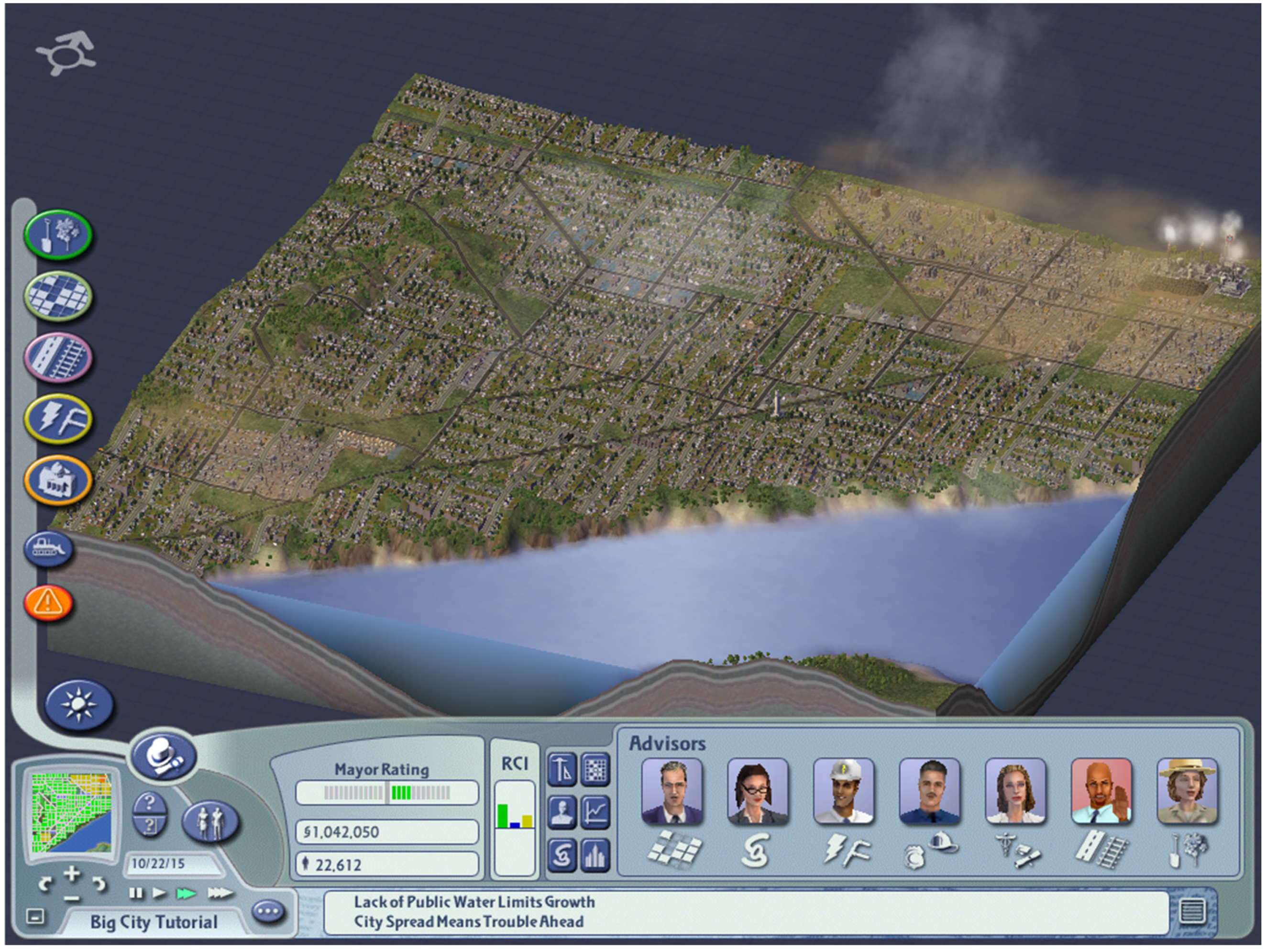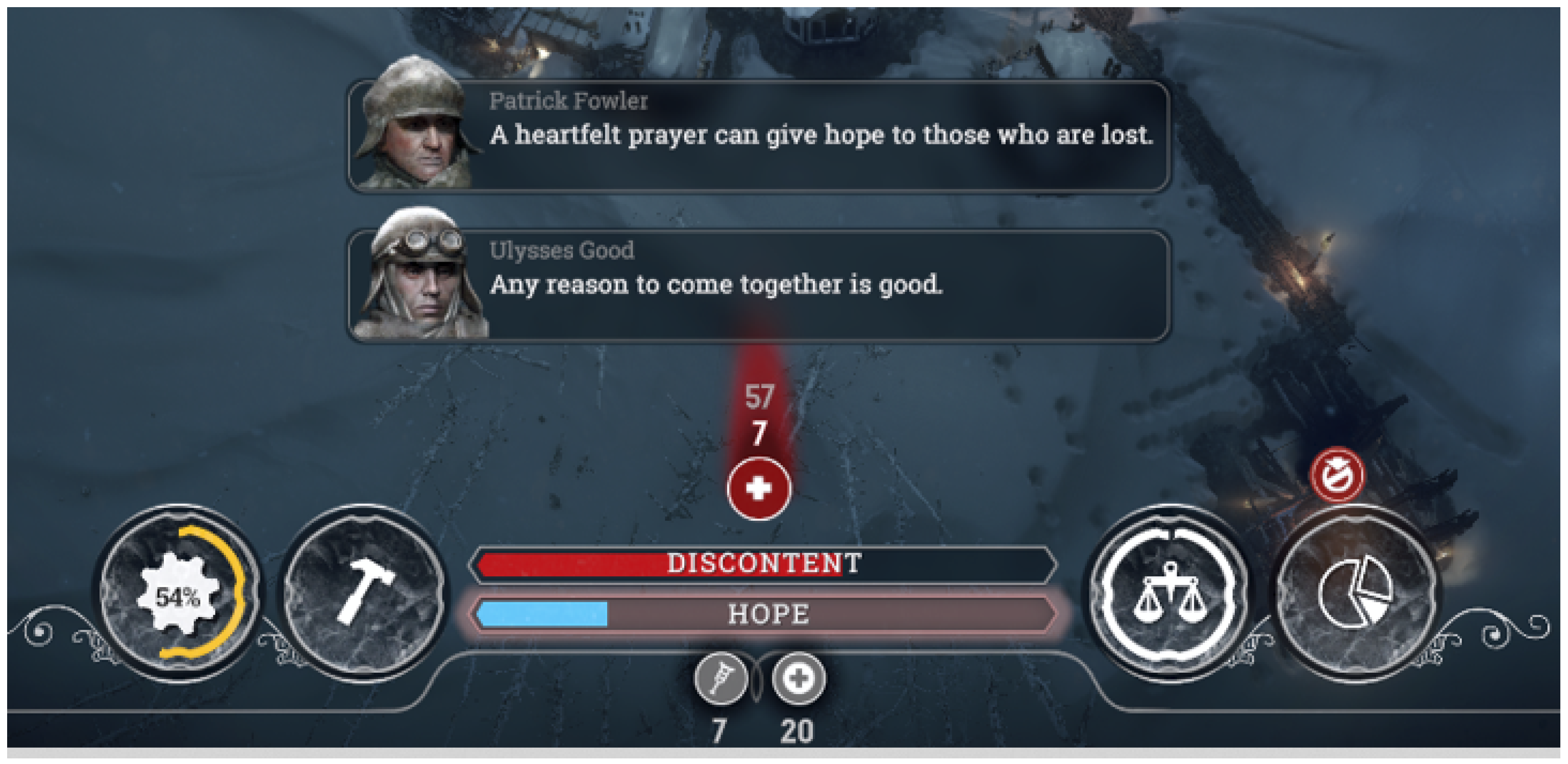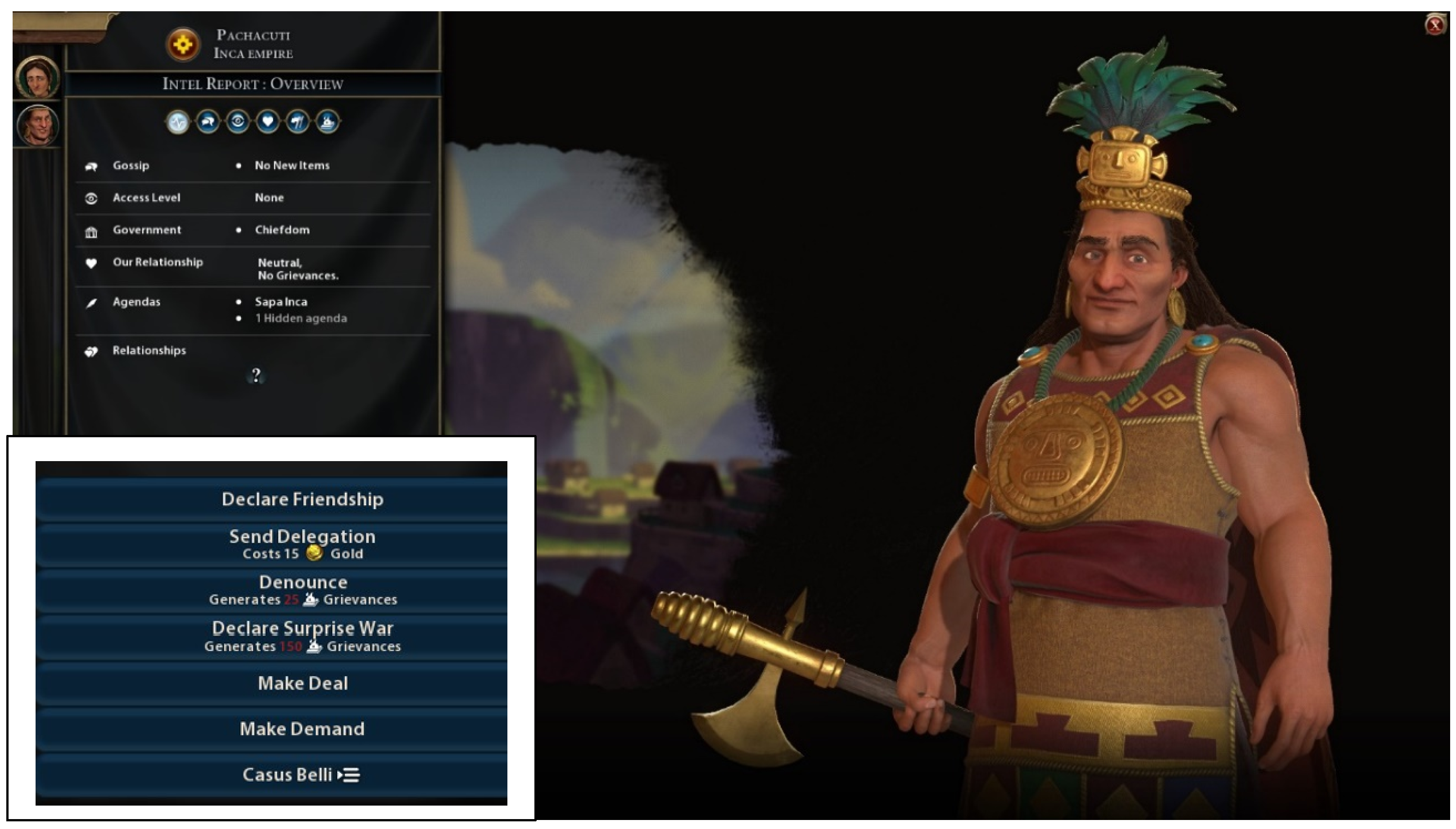Beyond Entertainment: Analyzing Multiperspectivity in Digital Strategy Games for Educational Purposes
Abstract
1. Introduction
- (1)
- What types of stakeholders are present in the games under study?
- (2)
- How do the stakeholders communicate their perspectives in the games and in which way is multiperspectivity expressed linguistically?
- (3)
- What conflicts arise from the different perspectives in the game and what solutions does the game design offer?
2. The State of Research
2.1. Multiperspectivity and Learning
2.2. Multiperspectivity and Digital Games
2.3. Conceptual Framework
3. Materials and Methods
3.1. Data Collection
3.2. Data Analysis
4. Results of the Game Analysis
4.1. What Types of Stakeholders Are Present in the Games Under Study?
4.2. How Do the Stakeholders Communicate Their Perspectives in the Games and in Which Way Is Multiperspectivity Expressed Linguistically?
4.3. What Conflicts Arise from the Different Perspectives in the Game and What Possible Solutions Does the Game Design Provide?
5. Discussion
Limitations
Author Contributions
Funding
Institutional Review Board Statement
Informed Consent Statement
Data Availability Statement
Acknowledgments
Conflicts of Interest
References
- Ataeian, A. (2013). Vom standpunkt des erkennens: Nietzsches philosophie des perspektivismus. LIT. [Google Scholar]
- Baßeng, G., & Budke, A. (2024). Reflexion über fachliche inhalte am beispiel des stadtaufbauspiels PocketCity durch Schüler* innen als grundlage für den geographieunterricht. GW-Unterricht, 172(4), 5–21. [Google Scholar] [CrossRef]
- Becker-Mrotzek, M., Grabowski, J., Jost, J., Knopp, M., & Linnemann, M. (2014). Adressatenorientierung und Kohärenzherstellung im Text. Zum Zusammenhang kognitiver und sprachlicher realisierter Teilkompetenzen von Schreibkompetenz Didaktik. Deutsch: Halbjahresschrift für die Didaktik der Deutschen Sprache und Literatur, 19(37), 21–43. [Google Scholar]
- Betsch, T., Funke, J., & Plessner, H. (2011). Denken-urteilen, entscheiden, problemlösen. Springer. [Google Scholar]
- Budke, A., & Czauderna, A. (2023). Mündige entscheidungen in digitalen spielen. Modellentwicklung und ergebnisse aus qualitativen interviews mit game designern. In F. Pettig, & I. Gryl (Eds.), Geographische bildung in digitalen kulturen (pp. 157–169). Perspektiven für Forschung und Lehre. [Google Scholar] [CrossRef]
- Budke, A., Gebele, D., Königs, P., Schwerdtfeger, S., & Zepter, A. (2020). Student texts produced in the context of material-based argumentative writing: Interdisciplinary research-related conception of an evaluation tool. RISTAL, 3, 108–125. [Google Scholar] [CrossRef]
- Chen, J. (2007). Flow in games (and everything else). Communications of the ACM, 50(4), 31–34. [Google Scholar] [CrossRef]
- Chen, J.-L., & Yeh, H.-J. ((2018,, May 28–31). Conflicts between local fisheries and recreational activities in an no-take zone (NTZ) of Taiwan: Perspectives of multiple stakeholders. OCEANS—MTS/IEEE Kobe Techno-Oceans (OTO) (pp. 1–5), Kobe, Japan. [Google Scholar] [CrossRef]
- Cohen, J. (2001). Defining Identification: A theoretical look at the identification of audiences with media characters. Mass Communication & Society, 4, 245–264. [Google Scholar]
- Csikszentmihalyi, M. (1990). Flow: The psychology of optimal experience. Harper & Row. [Google Scholar]
- Cuhadar, E., & Kampf, R. (2014). Learning about conflict and negotiations through computer simulations: The case of peace maker. International Studies Perspectives, 15(4), 509–524. [Google Scholar] [CrossRef]
- Czauderna, A., & Budke, A. (2020). How Digital strategy and management games can facilitate the practice of dynamic decision-making. Education Sciences, 10(4), 99. [Google Scholar] [CrossRef]
- Davis, M. H. (1994). Empathy: A social psychological approach. Brown & Benchmark. [Google Scholar]
- De Angeli, D., Finnegan, D. J., Scott, L., Bull, A., & O’Neill, E. ((2018,, October 28–31). Agonistic games: Multiperspective and unsettling games for a social change. 2018 Annual Symposium on Computer-Human Interaction in Play Companion Extended Abstracts (pp. 103–108), Melbourne, VIC, Australia. Available online: https://dl.acm.org/doi/abs/10.1145/3270316.3270594 (accessed on 16 October 2024).
- Denisova, A., & Cairns, P. (2015, April 18–23). First person vs. third person perspective in digital games: Do player preferences affect immersion? 33rd Annual ACM Conference on Human Factors in Computing Systems (pp. 145–148), Seoul, Republic of Korea. [Google Scholar] [CrossRef]
- Duncker, L. (1996). Zeigen und handeln. In Studien zur anthropologie der schule. Verlag Armin Vaas. [Google Scholar]
- Duncker, L. (2005). Professionalität des zeigens. Mehrperspektivität als prinzip der allgemeinen didaktik. In L. Duncker, W. Sander, & C. Surkamp (Eds.), Perspektivenvielfalt im unterricht (pp. 9–21). Kohlhammer. [Google Scholar]
- Elcheroth, G., Penic, S., Usoof, R., & Reicher, S. (2019). Multiple perspectives in conflict settings: An introduction. Journal of Social and Political Psychology, 7(2), 913–924. [Google Scholar] [CrossRef]
- Europarat. (2021). Gemeinsamer europäischer referenzrahmen für sprachen: Lernen, lehren, beurteilen. Available online: https://europass.europa.eu/de/what-common-european-framework-languages-cefr (accessed on 26 November 2024).
- Feilke, H. (2012). Was sind textroutinen? Zur theorie und methodik des forschungsfeldes. Schreib-und textroutinen. In H. Feilke, & K. Lehnen (Eds.), Theorie, erwerb und didaktisch-mediale modellierung (pp. 1–31). Lang. [Google Scholar]
- Feilke, H. (2014). Argumente für eine didaktik der textprozeduren. In Werkzeuge des schreibens. beiträge zur didaktik der textprozeduren (pp. 11–34). Fillibach. [Google Scholar]
- Gebele, D., & Zepter, A. L. (2016). Sprachsensibler Fachunterricht im inklusiven Kontext. In Sprachdidaktische perspektiven. Theorie, empirie, praxis. In der reihe KöBeS (Kölner beiträge zur sprachdidaktik) (pp. 108–136). Gilles & Francke Verlag. [Google Scholar]
- Gee, J. P. (2007). What video games have to teach us about learning and literacy (Rev. & updated ed.). Palgrave Macmillan. [Google Scholar]
- Gogolin, I., Lange, I., Michel, U., & Reich, H. H. (2013). Herausforderung Bildungssprache und wie man sie meistert (FörMig ed.). Waxmann. [Google Scholar]
- Hoffman, M. L. (1987). The contribution of empathy to justice and moral judgment. In N. Eisenberg, & J. Strayer (Eds.), Empathy and its development (pp. 47–80). Cambridge University Press. [Google Scholar]
- Horn, A., Visser, M., Pittens, C., Urias, E., Zweekhorst, M., & Dijk, G. (2024). Transdisciplinary learning trajectories: Developing action and attitude in interplay. Humanities and Social Sciences Communications, 11, 149. [Google Scholar] [CrossRef]
- Kampf, R., & Nicolaidou, I. (2024). Using social impact games to overcome intractable conflicts: The case of Fact Finders and PeaceMaker. Information, Communication & Society, 1–16. [Google Scholar] [CrossRef]
- Klimmt, C., & Hartmann, T. (2006). Effectance, self-efficacy, and the motivation to play video games. In P. Vorderer, & J. Bryant (Eds.), Playing video games: Motives, responses, and consequences (pp. 132–145). Erlbaum. [Google Scholar]
- Krüger, A. (2012). Multiperspectivity as a basis of current German physical education. Movement & Sport Sciences, 11–23. [Google Scholar] [CrossRef]
- Kuckuck, M. (2014). Konflikte im raum—Verständnis von gesellschaftlichen diskursen durch argumentation im geographieunterricht. In Geographiedidaktische Forschungen. Band 54. Monsenstein und Vannerdat. [Google Scholar]
- Lux, J.-D., & Budke, A. (2020a). Alles nur ein spiel? Geographisches Fachwissen zu aktuellen gesellschaftlichen Herausforderungen in digitalen spielen. GW Unterricht, 160, 22–36. [Google Scholar] [CrossRef]
- Lux, J.-D., & Budke, A. (2020b). Playing with complex systems? The potential to gain geographical system competence through digital gaming. Education Sciences, 10(5), 130. [Google Scholar] [CrossRef]
- Lux, J.-D., & Budke, A. (2023). Reflexives spielen? Wie junge spielende repräsentationen gesellschaftlicher themen in digitalen spielen reflektieren. MedienPädagogik: Zeitschrift für Theorie und Praxis der Medienbildung, 188–211. [Google Scholar] [CrossRef]
- Lux, J.-D., Budke, A., & Guardiola, E. (2021). Games versus reality? How game designers deal with current topics of geography education. Multimodal Technologies and Interaction, 5, 70. [Google Scholar] [CrossRef]
- Lütje, A., & Budke, A. (2021). Es sind doch begegnungen, wonach wir suchen. Narration und emotionalität im geographieschulbuch. GW-Unterricht, 161(1), 35–50. Available online: https://www.gw-unterricht.at/index.php/onlineausgaben/24-2021/80-161-2021.html (accessed on 22 September 2024). [CrossRef]
- Mayring, P. (2015). Qualitative inhaltsanalyse. Grundlagen und techniken. Beltz. [Google Scholar]
- Nicolaidou, I., Egenfeldt-Nielsen, S., Zupancic, R., Hajslund, S., & Milinoi, D. L. (2023). Developing fact finders: A mobile game for overcoming intractable conflicts. Social Science Computer Review, 41(4), 1166–1186. [Google Scholar] [CrossRef]
- Peng, W., Lee, M., & Heeter, C. (2010). The effects of a serious game on role-taking and willingness to help. Journal of communication, 60(4), 723–742. [Google Scholar] [CrossRef]
- Piaget, J. (1975). L’équilibration des structures cognitives. In Problème central du développement. Presses Universitaires de France. [Google Scholar]
- Reinhardt, S. (2004). Demokratie-kompetenzen. In W. Edelstein, & P. Fauser (Eds.), Beiträge zur demokratiepädagogik. eine schriftenreihe des BLK-programms: “demokratie lernen & leben” (pp. 1–27). BLK. Available online: https://www.pedocs.de/volltexte/2008/163/pdf/Reinhardt.pdf (accessed on 13 September 2024).
- Reitschert, K., & Hößle, C. (2006). Die struktur von bewertungskompetenz. Ein beitrag zur dimensionierung eines kompetenzmodells im bereich der bioethik. In H. Vogt, & D. Komatsu (Eds.), Peace education approach: Unity in diversity? Education and social cohesion in a post-conflict and divided nation. Springer. [Google Scholar] [CrossRef]
- Reuber, P. (2001). Möglichkeiten und Grenzen einer handlungsorientierten Politischen Geographie. In P. Reuber, & G. Wolkersdorfer (Eds.), Politische geographie. Handlungsorientierte ansätze und critical geopolitics (pp. 77–92). Selbstverlag des Geographischen Instituts der Universität Heidelberg. [Google Scholar]
- Rezat, S. (2011). Schriftliches Argumentieren: Zur Ontogenese konzessiver argumentationskompetenz. Didaktik Deutsch, 31, 50–67. [Google Scholar]
- Rhode-Jüchtern, T. (1995). Raum als text. Prinzipien einer konstruktiven erdkunde. In Materialien zur didaktik der geographie und wirtschaftskunde Bd. 11. Institut für Geographie der Universität Wien. [Google Scholar]
- Ryan, R. M., Rigby, C. S., & Przybylski, A. (2006). The motivational pull of video games: A self-determination theory approach. Motivation and Emotion, 30, 347–363. [Google Scholar] [CrossRef]
- Selman, R. L. (1984). Die entwicklung des sozialen verstehens. Entwicklungspsychologische und klinische untersuchungen. Suhrkamp. [Google Scholar]
- Spinner, K. H. (2006). Literarisches lernen. Praxis Deutsch, 200, 6–16. [Google Scholar]
- Stenros, J. (2016). The game definition game: A review. Games Cult, 12, 499–520. [Google Scholar] [CrossRef]
- Stöber, G. (2001). Multiperspektivität im geographieschulbuch. In G. Stöber (Ed.), Multiperspektivität im geographieunterricht. internationale schulbuchforschung bd. 23 (pp. 439–452). Verlag Hahnsche Buchhandlung. [Google Scholar]
- Vasiljuk, D., & Budke, A. (2021a). Akteure im rahmen des perspektivenwechsels: Ergebnisse einer analyse von geographiedidaktischen unterrichtsmaterialien. GW-Unterricht, Heft, 162, 18–30. [Google Scholar] [CrossRef]
- Vasiljuk, D., & Budke, A. (2021b). Multiperspectivity as a process of understanding and reflection: Introduction to a model for perspective-taking in geography education. European Journal of Investigation in Health, Psychology and Education, 11, 529–545. Available online: https://www.mdpi.com/2254-9625/11/2/38/pdf (accessed on 7 November 2024). [CrossRef] [PubMed]
- Voegeli, G., & Finger, D. C. (2021). Disputed dams: Mapping the divergent stakeholder perspectives, expectations, and concerns over hydropower development in Iceland and Switzerland. Energy Research and Social Science, 72, 101872. [Google Scholar] [CrossRef]
- Vorderer, P. (2000). Interactive entertainment and beyond. In D. Zillmann, & P. Vorderer (Eds.), Media entertainment: The psychology of its appeal (pp. 21–36). Erlbaum. [Google Scholar]
- Wansink, B., Akkerman, S., Zuiker, I., & Wubbels, T. (2018). Where does teaching multiperspectivity in history education begin and end? An analysis of the uses of temporality. Theory and Research in Social Education, 46(4), 495–527. [Google Scholar] [CrossRef]
- Wilson, P.-J. (2021). Climate change inaction and optimism. Philosophies, 6(3), 61. [Google Scholar] [CrossRef]
- Yakter, A., & Tessler, M. (2018). Understanding multiple perspectives: The contribution of a short-essay assignment to teaching about the Arab–Israeli conflict. PS Political Science & Politics, 51, 434–439. [Google Scholar] [CrossRef]
- Zagal, J. P., Mateas, M., Fernández-Vara, C., Hochhalter, B., & Lichti, N. (2007, June 16–20). Towards an ontological language for game analysis. Digital Games Research Conference 2005, Changing Views: Worlds in Play (pp. 1–13), Vancouver, BC, Canada. [Google Scholar]




| Category of Analysis | Question for Analysis | Game Analysis Anchor Data Example |
|---|---|---|
| (1) Types of stakeholders | Who are the stakeholders in the game? | Banished: The stakeholders of the game are inhabitants of a village in a struggle for survival against nature. They are simulated with their attributes on an individual level and summarised collectively as a whole population via averaged values. |
| (2) Number of stakeholders | How many stakeholders are in the game? | SimCity4: There are up to five player-created residents (Sims) and seven advisors from the areas of urban planning, finance, public affairs, safety, health and education, and transport and environmental protection, as well as the total population as one actor. |
| (3) Representation of stakeholders | How are the stakeholders presented? | Cities: Skylines: The inhabitants of the city move through the city visually. They can also be clicked on and tracked. Clicking on them reveals their name, age, education level, place of residence, and place of employment. If you zoom in close enough, you can see the avatar of the character. |
| (4) Actor communication | How do the stakeholders communicate their perceptions, interests, and goals in the game? | Tropico 6: The interest groups and superpowers, as well as the broker, communicate their needs through missions that can be rejected or accepted by the player. Completing the mission improves relations with the respective actor and unlocks rewards. Rejection or failure of the mission leads to a deterioration of relations with the mission giver. |
| (5) Areas of linguistic competence | Which language competencies (reading, listening, writing, speaking) are present and to what extent are they addressed in the game? | Cities: Skylines: A few short informative and explanatory texts must be read. There is no hearing, writing, or speaking in the game. |
| (6) Language operations and text procedures | What linguistic schemes of action and corresponding text procedures that mark different positions occur? | Tropico 6: Because the game contains several texts in which different stakeholders convince the player of their opinion, there are argumentative language operations and text procedures for positioning, perspectivising, conceding, and comparing. |
| (7) Controversial views and conflicts | To what extent do conflicts of interest exist between the stakeholders in the game? | Tropico 6: The interest groups impose ultimatums, and the expiry of an ultimatum has strong negative effects. These can be economic crises, strikes, or even coup attempts. It can happen that two interest groups make opposing demands on the player and he/she has to choose between them. |
| (8) Possible solutions for conflicts | How are conflicts between stakeholders handled? | Anno 2070: The three meta-factions resolve their conflicts through democratic elections in the World Council. The settlements sanction misconduct through military attacks. One can also conclude diplomatic agreements and trade. |
| Games | Total Population | Groups | Individual Stakeholders | 4 Other Players | ||||
|---|---|---|---|---|---|---|---|---|
| Tropico 6 | ⊠ | ◻ | ◻ | ⊠ | ||||
| Anno 2070 | ⊠ | ⊠ | ◻ | ⊠ | ||||
| Democracy 3 | ⊠ | ⊠ | ⊠ | ◻ | ||||
| SimCity 4 Deluxe Edition | ⊠ | ⊠ | ⊠ | ⊠ | ||||
| Anno 1800 | ⊠ | ◻ | ⊠ | ⊠ | ||||
| Banished | ⊠ | ◻ | ⊠ | ◻ | ||||
| SimCity BuildIt | ⊠ | ◻ | ⊠ | ◻ | ||||
| Age of Empires 2 | ◻ | ◻ | ◻ | ⊠ | ||||
| Cities: Skylines | ⊠ | ◻ | ⊠ | ◻ | ||||
| Overcrowd | ⊠ | ◻ | ⊠ | ◻ | ||||
| Rise of Industry | ⊠ | ⊠ | ◻ | ◻ | ||||
| Civilization 6 | ⊠ | ◻ | ◻ | ⊠ | ||||
| Frostpunk | ⊠ | ◻ | ⊠ | ◻ | ||||
| Die Siedler 7 | ◻ | ◻ | ◻ | ⊠ | ||||
| Fate of the World | ⊠ | ◻ | ◻ | ◻ | ||||
| Transport Fever | ◻ | ◻ | ⊠ | ◻ | ||||
| Eco | ◻ | ◻ | ◻ | ⊠ | ||||
| Overall | 14 | 82.4% | 5 | 29.4% | 11 | 64.7% | 7 | 41.2% |
Disclaimer/Publisher’s Note: The statements, opinions and data contained in all publications are solely those of the individual author(s) and contributor(s) and not of MDPI and/or the editor(s). MDPI and/or the editor(s) disclaim responsibility for any injury to people or property resulting from any ideas, methods, instructions or products referred to in the content. |
© 2025 by the authors. Licensee MDPI, Basel, Switzerland. This article is an open access article distributed under the terms and conditions of the Creative Commons Attribution (CC BY) license (https://creativecommons.org/licenses/by/4.0/).
Share and Cite
Budke, A.; Czauderna, A.; Gebele, D.; Zepter, A.L. Beyond Entertainment: Analyzing Multiperspectivity in Digital Strategy Games for Educational Purposes. Educ. Sci. 2025, 15, 479. https://doi.org/10.3390/educsci15040479
Budke A, Czauderna A, Gebele D, Zepter AL. Beyond Entertainment: Analyzing Multiperspectivity in Digital Strategy Games for Educational Purposes. Education Sciences. 2025; 15(4):479. https://doi.org/10.3390/educsci15040479
Chicago/Turabian StyleBudke, Alexandra, André Czauderna, Diana Gebele, and Alexandra L. Zepter. 2025. "Beyond Entertainment: Analyzing Multiperspectivity in Digital Strategy Games for Educational Purposes" Education Sciences 15, no. 4: 479. https://doi.org/10.3390/educsci15040479
APA StyleBudke, A., Czauderna, A., Gebele, D., & Zepter, A. L. (2025). Beyond Entertainment: Analyzing Multiperspectivity in Digital Strategy Games for Educational Purposes. Education Sciences, 15(4), 479. https://doi.org/10.3390/educsci15040479





